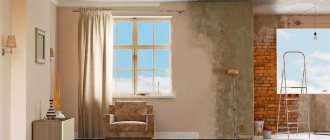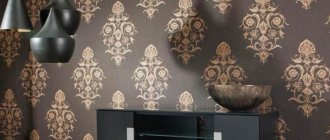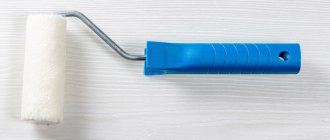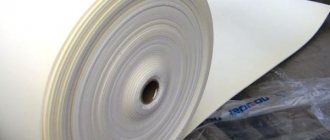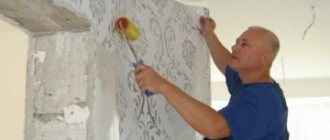| № | Name | Rating | Nomination |
| 1 | GLIMS PrimeGround | 4.88 | Optimal ratio of price and quality of coating |
| 2 | KNAUF Tiefengrund | 4.85 | Universal composition for interior and exterior work |
| 3 | Ceresit CT 17 | 4.65 | The most popular |
| 4 | Axton | 4.60 | Low price |
| 5 | VGT | 4.57 | Largest volume |
| 6 | Intercolor | 4.56 | Best drying time |
| 7 | Tikkurila Euro Primer | 4.55 | Suitable for processing fibreboards |
| 8 | TEX Pro | 4.50 | Affordable concentrated primer |
| 9 | Formula Q8 (Prestige) | 4.50 | High resistance to freezing |
| 10 | Prospectors | 4.10 | A reliable product for removing dust and strengthening walls |
Popular manufacturers
The most popular liquid compositions for preparing walls for finishing are produced by the brands GLIMS, KNAUF and Ceresit. Primers from these manufacturers are considered the most effective.
Products from GLIMS
They dry quite quickly, are perfectly absorbed and protect the coating from mold formation. In addition, building materials from this brand are sold at a very affordable price.
KNAUF
produces more expensive primer with a wide range of applications. True, German quality has recently begun to fail: counterfeits are becoming more and more common. But even despite this, even experienced builders continue to use building materials from KNAUF. The main thing is to know where to buy.
Ceresit
considered one of the most popular brands. The manufacturer produces high-quality primers for a variety of tasks. The quality of mixtures and building materials produced under this brand remains unchanged. But, having decided to buy primer from Ceresit, you need to decide what you need it for. Not all compositions can be applied under light wallpaper and used for painting.
How to choose a primer
Building materials of this type differ in purpose and form of release: dry, liquid and concentrated. It is better to select a product according to your needs and the base material that needs to be treated.
For weak grounds
The best option would be a deep penetration strengthening primer. It will not only remove dust, but also protect the surface from further destruction. It is especially important to apply such a primer before pasting walls with heavy multi-layer wallpaper.
For rooms with high humidity levels
formulations containing antiseptic and antifungal components are more suitable. Such products prevent the appearance of mold under the finish coating.
Walls that do not have serious defects
It is recommended to treat with the simplest liquid primers. They are more affordable than products with an antifungal/antiseptic composition, have virtually no odor, and dry much faster. Their only task is to strengthen the adhesion of glue and wallpaper to the base.
In any residential premises it is better to use water-based acrylic primers. Such products do not contain organic solvents and are completely safe.
Surface preparation
Before applying primer, you need to properly prepare the surface:
- it is advisable to completely remove the old coating;
- wash away traces of rust and various stains, you can treat them with copper sulfate;
- qualitatively remove all greasy stains;
- remove traces of soot;
- putty on the surface of various chips, cracks, seams, and other defects.
Top 10. Prospectors
Rating (2021): 4.10
8 reviews from resources taken into account: Reviewer
A reliable means for removing dust and strengthening walls. The soil adheres well to the surface, strengthens weak plaster and prevents the wallpaper from falling away from the base over time.
- Characteristics
Average price: 350 rub.
- Volume: 10 l
- Type: for interior work
- Drying speed: 1 hour
- Consumption per 1 m²: 0.1-0.2 l
An acrylic primer that copes well with minor imperfections in plastered walls and ceilings. Strengthens the adhesive properties of wallpaper glue, has a white color and a weak, unobtrusive odor. Apply using a brush, roller or spray. The consistency is liquid, but does not spread. By the way, its consumption, according to reviews, is quite acceptable: one 10-liter bottle is enough for 50 m². But for processing gas and foam concrete, concrete, monolithic blocks, you will have to increase the consumption. The fact is that the penetrating and strengthening abilities of the product are only enough to prepare for painting/wallpapering. But for “raw” surface treatment without preliminary plastering, the primer must be applied in 2 layers. Hence the low rating.
Advantages and disadvantages
- Can be applied to floors, walls and ceilings
- Contains antiseptic
- Does not foam and does not spread
- Ineffective when treating unplastered surfaces
Concrete contact: soil properties and its application
Concrete contact is a special type of primer composition, which has recently become widely used.
This material is produced on the basis of a dispersion of acrylate resins with the addition of mineral chips. After applying to the surface and drying, it forms a kind of film. The surface of this film is covered with small hard particles, which create a roughness effect. Typically, concrete contact is painted pink. This was done to make it easier to visually determine whether the area is completely primed or whether there are gaps in it. The presence of any gaps in the treated surface may negatively affect the effectiveness of the primer.
Many people believe that concrete contact primer is universal and can be used on any type of surface and for any subsequent work. This statement is erroneous. The main purpose of the material is as follows:
Concrete contact is a primer that is intended exclusively for the preparation of weakly absorbent substrates for subsequent application of plaster.
Low-absorbent substrates include monolithic concrete, found in panel houses. It is also allowed to apply concrete contact to old paint if it is impossible to remove it from the surface by any means. This primer will be effective for treating floor slabs in order to prepare ceilings for thin-layer plastering.
Any type of cement or gypsum plasters can be applied to a surface primed with concrete contact. Moreover, concrete contact behaves best with gypsum-based solutions. There are at least two reasons for this:
- reduction of water absorption of walls to almost zero;
- imparting roughness to the treated surface.
Gypsum plasters quickly release moisture.
When applied in a thick layer, this property can lead to uneven water absorption throughout the plaster structure. It will begin, tritely, to “slide” from the walls even before it fully adheres to the surface. The waterproof concrete contact film allows you to avoid the formation of this effect. And additional grains of mineral chips on the surface will provide additional adhesion to the gypsum. Concrete contact is a vapor-permeable primer. This is also an important factor when choosing materials for finishing residential premises. Due to this property, the soil will not prevent the walls from “breathing.” It will not be the root cause of the appearance of fungi and mold under the plaster.
Which concrete contact primer should I buy?
A good concrete contact primer must be of proper quality: have a sufficient content of polymers in the composition and a clear proportion of mineral fillers. We recommend using the following types of concrete contact:
Primer concrete contact Ceresit CT 19. This is a high-quality primer with the addition of quartz sand. Provides adhesion strength to weakly absorbent substrates up to 1.5 MPa. One of the few primers recommended by the manufacturer for subsequent laying of ceramic tiles. The product is frost-resistant, so it can be used outside buildings on vertical surfaces. Ideal for subsequent plastering with cement and gypsum plasters.- Primer EK Betonkontakt is a composition based on acrylate resin. Easy to apply and dries quickly. Significantly increases adhesion due to the properties of the polymer film and quartz sand in the composition. Recommended for installation of plasters and tile work.
- Primer Knauf Betonkontakt. Acrylic dispersion with ceramic sand, which is used for preparing gypsum materials and cellular concrete for subsequent plastering with gypsum plasters.
Top 9. Formula Q8 (Prestige)
Rating (2021): 4.50
5 reviews from resources were taken into account: Reviewer
High resistance to freezing The composition remains effective even after 5 freeze/thaw cycles.
- Characteristics
Average price: 239 rub.
- Volume: 5 l
- Type: antiseptic
- Drying speed: 0.5-24 hours.
- Consumption per 1 m²: 50-100 ml
White acrylic primer that leaves no marks during application. Suitable for treating bases made of brick, concrete, as well as plastered surfaces before gluing non-woven, liquid, paper wallpaper. After complete drying, the primer forms a dense, but at the same time vapor-permeable film, resistant to contact with moisture. In addition, the product significantly enhances the adhesion of glue and reduces its consumption. And the liquid does not smell: no irritating odor and no increase in humidity in the room, both during the work and after the coating has dried. True, when processing the base it is difficult to see the uncoated areas. But this drawback is fully compensated by the transparency of the finished protective film and the absence of harmful components in the composition of the soil.
Advantages and disadvantages
- Contains no hazardous solvents
- Without smell
- Does not change the color of the treated surface
- Applies evenly
- When applied, it is not visible in which place the base has been treated and in which it has not.
Selection rules
When choosing a material for wall treatment, you should determine the type of work and the condition of the surface. There are several types of emulsions:
- antifungal – used for bleaching rooms with high humidity;
- anti-corrosion – applied to metal surfaces;
- deep-penetrating - used to strengthen old foundations.
- primer - waterproofing - the top layer is treated with it to protect against residual moisture;
- primer-paint – used to protect surfaces such as wood, metal and porous materials;
- a special primer - it strengthens the bleaching layers.
There are several types of primer based on their composition:
- Acrylic – scope of application: wood, plaster, brick. It dries quickly and has no specific odor.
- Alkyd – scope of application: metal, wood, glass, fiberglass. Has good adhesion.
- Epoxy - it coats metal surfaces to protect against corrosion. It is resistant to mechanical and temperature influences, but takes a very long time to dry.
- Cement - it is used for processing concrete walls and gas silicate blocks. The mixture dries quickly and is an environmentally friendly material.
- Polystyrene - it is used for plastered and treated walls. The mixture is resistant to moisture, but is highly toxic.
- Phenolic - intended for the initial coating of wood or metal. The mixture is durable and has anti-corrosion properties. Disadvantages include long drying time.
Top 8. TEX Pro
Rating (2021): 4.50
Affordable concentrated primer The product is sold at a very reasonable price with a volume of 5 liters. After dilution, the user receives as much as 20 liters of soil.
- Characteristics
Average price: 749 rub.
- Volume: 5 l
- Type: strengthening, concentrated 1:3
- Drying speed: 1-1.5 hours.
- Consumption per 1 m²: from 0.03 l
Impregnating primer with high drying speed. The composition diluted with water 1 to 3 quickly penetrates into the structure of the base and removes dust well. Suitable for treating walls made of concrete, wood and plasterboard. Retains its dust-removing properties even when fully diluted. However, even the manufacturer himself does not recommend diluting the soil to strengthen weak surfaces. It is better to use the solution without adding water, otherwise you will not be able to achieve the desired result. The soil has no other significant drawbacks: both in price and in efficiency, the product is no worse than more expensive building materials.
Advantages and disadvantages
- Helps remove dust from any surface
- Optimal drying time
- Can be used for facade work
- A diluted solution is not suitable for strengthening the base
Top 7. Tikkurila Euro Primer
Rating (2021): 4.55
7 reviews from resources taken into account: Yandex.Market
Suitable for processing fibreboards. The product can be used not only for priming under wallpaper, but also for preparing floors and wooden surfaces for painting.
- Characteristics
Average price: 179 rub.
- Volume: 0.9 l
- Type: concentrated 1:3, acrylic, antifungal
- Drying speed: 1-1.5 hours.
- Consumption per 1 m²: 0.07-0.2 l
Deep penetration primer for wallpaper, painting, plaster and other finishing coatings. It is versatile: can be used indoors as well as for outdoor use. Diluted with water in a ratio of 1:3: three parts water to 1 part primer. Judging by the reviews, the composition does not have an unpleasant odor and is well distributed over almost any surface. True, it does not have covering and strengthening properties, which is why the soil cannot be used on crumbling plaster. But for preparing for the finishing of walls, ceilings and floors in the bathroom, kitchen and other rooms, the composition is ideal. It protects the base from the formation of fungus and also has an antiseptic effect.
Advantages and disadvantages
- Wide range of applications
- Prevents the appearance of mold
- Has enhanced penetrating properties
- Not suitable for weakened coatings
- Does not tolerate freezing
Preparing the composition at home
For those who do not have the opportunity to purchase a ready-made primer or simply do not trust purchased compounds and cannot choose the right one, you can make the mixture yourself. To do this, you need to stock up on some components:
- boiling water - 7 liters;
- drying oil - 100 grams;
- laundry soap - 150 grams;
- lime - 2 kg.
To prepare the composition, you will need a bucket in which the components will be mixed; for grinding, you need a grater and a fine sieve. Exactly half of the boiling water is poured into the bucket, the grated soap is dissolved in it, and everything is stirred. Afterwards, drying oil is added.
In a separate container, dissolve the lime in the remaining boiling water. Then both solutions are combined, mixed, and the liquid is passed through a sieve.
Priming begins after the composition has completely cooled.
Soap should be rubbed into a homemade primer first, then it will dissolve much faster
Top 6. Intercolor
Rating (2021): 4.56
6 reviews from resources taken into account: Castorama.ru
Best drying time Acrylic primer dries completely within 30 minutes. This is the fastest drying composition in the selection.
- Characteristics
Average price: 199 rub.
- Volume: 10 l
- Type: universal, acrylic
- Drying speed: 0.5 hours.
- Consumption per 1 m²: 0.5-1.2 l
A quick-drying, deep-penetrating primer suitable for strengthening and removing dust from any mineral substrates. It is applied to the wall with a roller or brush, or you can also use a spray gun. The product is not pigmented, milky white in color. During application it does not change the shade of the treated surface. Thanks to this feature, the primer can be used under wallpaper of any type and color: from snow-white paper, non-woven to textured liquid and bright vinyl, photo wallpaper. The only downside users highlight is the excessive formation of foam when working with the primer. But this drawback pales in comparison to the adequate cost, economical consumption and versatility of the composition.
Advantages and disadvantages
- Does not contain hazardous solvents
- Provides good adhesion
- Dries almost instantly
- The composition foams a lot
Top 5. VGT
Rating (2021): 4.57
14 reviews from resources taken into account: Yandex.Market, Petrovich.ru
The largest volume The weight of soil without containers is 15 kg. This is the maximum figure in the ranking.
- Characteristics
Average price: 1443 rub.
- Volume: 15 l
- Type: covering, adhesive
- Drying speed: 1-24 hours.
- Consumption per 1 m²: 0.15-0.2 kg
White acrylic pigmented primer. Suitable for both wallpapering and subsequent painting of walls and ceilings. The main difference between primer is that it also acts as paint. After treatment, the surface is not only dust-free, but also acquires an even matte white color. This building material is ideal for beginners: even a layman can handle applying primer. The product improves the adhesion of wallpaper glue and paint to surfaces made of aerated concrete, stone, concrete, brick and plasterboard. In addition, it does a good job of strengthening crumbling foundations. The only serious drawback is that the soil is quickly consumed due to its thick consistency.
Advantages and disadvantages
- Withstands 5 freezing cycles
- Creates a matte finish
- Protects the surface from cracking and dust
- High consumption
- Thick
Top 4. Axton
Rating (2021): 4.60
15 reviews from resources were taken into account: Otzovik, Leroymerlin.ru
Low price This is the cheapest wallpaper primer in the rating. The product is not only inexpensive, it also works effectively and does not leave stains after drying.
- Characteristics
Average price: 101 rub.
- Volume: 2.5 l
- Type: for dry rooms
- Drying speed: 0.5-2 hours.
- Consumption per 1 m²: 0.1 l
Environmentally friendly water-based primer. It is distinguished by a very low price for this type of material, as well as ease of application and virtually no odor. Suitable for treating walls and ceilings made of plaster and concrete. Penetrates deep into the base and prevents the rapid absorption of wallpaper glue. The composition is white, not very pigmented, and after complete drying it becomes completely transparent. The primer removes dust from the surface, is compatible with glue for any wallpaper (paper, non-woven, vinyl, photo wallpaper), and is also quite economical in consumption. Users assure that a 2.5 liter bottle is enough for a room of 30-32 m², when the manufacturer says only 25 m². But the primer has one drawback - it is liquid. Therefore, it is better to apply it with a roller, squeezing it thoroughly each time.
Advantages and disadvantages
- Very low price
- Colorless
- Wash off from tools with plain water
- Effectively improves the adhesion of wallpaper to the wall
- Spreads
Special primer-paint Semin 5 l in Moscow
Special primer paint Semin 5 l and other products in this category are available in the catalog of the Leroy Merlin online store in Moscow at low prices. Read the detailed characteristics and description, as well as reviews of this product, to make the right choice and order the product online.
Buy products such as Semin special primer paint 5 l in the Leroy Merlin online store, having first checked their availability. You can receive the goods in Moscow in a way convenient for you; to do this, read the information about delivery and pickup.
You can always place an order and pay for it online on the official website of Leroy Merlin in Russia. For residents of the Moscow region, we not only have low prices for products such as “Special primer-paint Semin 5 l”, but also fast delivery to cities such as Moscow, Balashikha, Podolsk, Khimki, Korolev, Mytishchi, Lyubertsy, Krasnogorsk, Elektrostal, Kolomna, Odintsovo, Domodedovo, Serpukhov, Shchelkovo, Orekhovo-Zuevo, Ramenskoye, Dolgoprudny, Pushkino, Reutov, Sergiev Posad, Voskresensk, Lobnya, Ivanteevka, Dubna, Yegoryevsk, Chekhov, Dmitrov, Vidnoye, Stupino, Pavlovsky Posad, Nar- Fominsk, Fryazino, Lytkarino, Dzerzhinsky, Solnechnogorsk, Istra and Zhukovsky.
Top 3. Ceresit CT 17
Rating (2021): 4.65
170 reviews from resources were taken into account: Yandex.Market, Otzovik, Leroymerlin.ru
The most popular The product has received a large number of reviews in the rating. The composition is recommended by many professional builders.
- Characteristics
Average price: 600 rub.
- Volume: 10 l
- Type: firming
- Drying speed: from 2 to 4 hours.
- Consumption per 1 m²: 0.1-0.2 l
An affordable and easy-to-use deep penetration primer for non-woven, paper, liquid and other wallpapers. The basis of the product is water-dispersion. The primer contains a yellow pigment, which makes it easy to distinguish the primed coating from an unprimed surface. After application, it creates a film that improves the adhesion of wallpaper glue, binds dust and strengthens the base. This pigmented primer can be used not only for walls, but also for floors, ceilings, and also for exterior applications. True, the yellow pigment included in the product makes it far from being so universal. The primer is absolutely not suitable for subsequent finishing painting in light colors: the shade CT 17 will either bleed through the layers of paint or distort the color.
Advantages and disadvantages
- Prevents mold formation
- There is no chalk dust after application
- Forms a smooth surface that does not absorb moisture
- Does not contain hazardous components
- Leaves yellow stains on finishing putty
- Has an unpleasant odor
See also:
- 10 best liquid wallpaper manufacturers
Top 2. KNAUF Tiefengrund
Rating (2021): 4.85
64 reviews from resources were taken into account: Yandex.Market, Leroymerlin.ru, Otzovik, Sidex.ru
A universal composition for interior and exterior work. The primer can be used both for treating walls, ceilings, and for preparing the facade for painting.
- Characteristics
Average price: 750 rub.
- Volume: 10 l
- Type: strengthening, vapor permeable
- Drying speed: from 3 hours.
- Consumption per 1 m²: 0.07-0.1 kg
One of the most popular deep penetration primers for wallpaper. Suitable not only for indoor but also for outdoor use. It performs well when gluing non-woven, vinyl, liquid wallpaper, painting walls and facades. The composition itself is pigmented, white, and does not change shade after application. This primer is used for treating drywall, plaster, cement bases, and gypsum building boards. The product does not require dilution and is completely ready for use. The soil has a smell, but it dissipates quite quickly. Most users have no complaints about the quality of the coating, but some were “lucky” to purchase a fake. Low-quality compositions contain little dry matter and do not strengthen or remove dust from the surface.
Advantages and disadvantages
- Economically used
- Improves the properties of wallpaper adhesive
- Does not leave stains and is easy to clean
- Has excellent vapor permeability
- There are fakes
See also:
- 10 Best Wallpaper Adhesives
Primers for walls under wallpaper: features of application and application
The process of wallpapering is perceived by many as a fairly simple undertaking that does not require any special skills or preparatory work. And then surprise and disappointment comes, because the applied coating peels off. Therefore, you need to remember that there are a number of works that must precede the process of creating decorative finishes. Thus, a primer for walls under wallpaper is a prerequisite for high-quality repairs.

